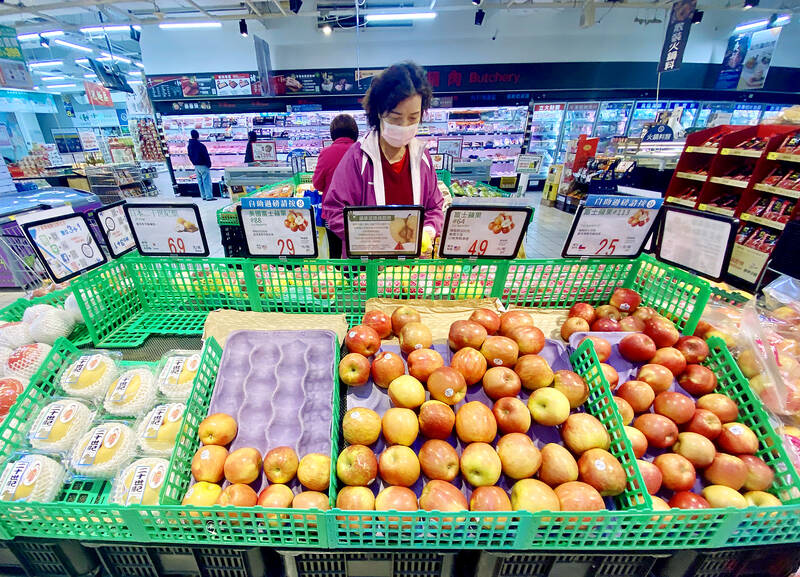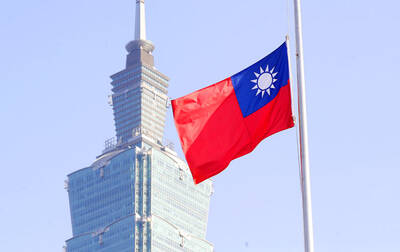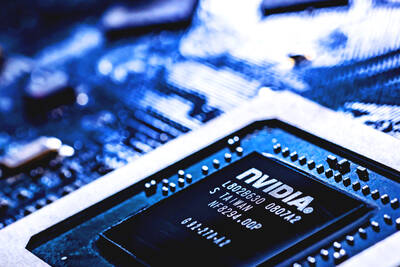The business climate monitor in December signaled “blue” for a second straight month, as exports, industrial output and other economic indicators contracted, while consumer spending gained traction, the National Development Council said yesterday.
The total score of nine monitoring indicators was unchanged at 12, reflecting a recession induced by global inflation and monetary tightening, council research director Wu Ming-huei (吳明蕙) said.
“Foreign trade, a key growth driver, would remain weak in the coming months, but might come out of the woods earlier as global inflationary pressures have showed signs of stabilizing,” Wu said.

Photo: CNA
The sub-index on retail, wholesale and dining revenue gained 1 point in December, but imports of electrical and machinery equipment retreated by the same pace, Wu said.
The council uses a five-color system to portray the nation’s economic health, with “green” signifying steady growth, “red” suggesting a boom and “blue” reflecting a recession. Dual colors suggest transition to a stronger or weaker state.
Rising inflation and interest rate hikes led consumers around the world to cut spending on technology gadgets, prompting major tech titans to shed headcount and manage inventory cautiously, the official said.
This might persist through the first half of this year, but a few steelmakers and electronics suppliers are expecting a turnaround next quarter, encouraged by China’s reopening and swift easing of COVID-19 restrictions.
The index of leading indicators, which projects the economic situation in the coming six months, weakened in December for the 13th straight month, albeit at a milder pace, Wu said, adding that the chance of a rebound is unlikely until the third quarter.
The index has declined 8.1 percent in the past 13 months, council data showed.
The index of coincident indicators, which reflects the current economic situation, shrank 2.08 percent to 92.06, as almost all constituent measures lost value except for the sub-index on non-farm payroll, the council said.
Service providers catering to domestic demand saw a rapid recovery in December, as companies held year-end banquets for employees, Wu said.
The momentum is expected to carry on into this month, as companies organize spring gatherings to celebrate the new year, he said.
In addition, demand for electronics used in high-performance computing, electric vehicles and emerging technology applications should thrive, while inventory corrections linger for smartphones and notebook computers, the council said.

When Lika Megreladze was a child, life in her native western Georgian region of Guria revolved around tea. Her mother worked for decades as a scientist at the Soviet Union’s Institute of Tea and Subtropical Crops in the village of Anaseuli, Georgia, perfecting cultivation methods for a Georgian tea industry that supplied the bulk of the vast communist state’s brews. “When I was a child, this was only my mum’s workplace. Only later I realized that it was something big,” she said. Now, the institute lies abandoned. Yellowed papers are strewn around its decaying corridors, and a statue of Soviet founder Vladimir Lenin

ELECTRONICS BOOST: A predicted surge in exports would likely be driven by ICT products, exports of which have soared 84.7 percent from a year earlier, DBS said DBS Bank Ltd (星展銀行) yesterday raised its GDP growth forecast for Taiwan this year to 4 percent from 3 percent, citing robust demand for artificial intelligence (AI)-related exports and accelerated shipment activity, which are expected to offset potential headwinds from US tariffs. “Our GDP growth forecast for 2025 is revised up to 4 percent from 3 percent to reflect front-loaded exports and strong AI demand,” Singapore-based DBS senior economist Ma Tieying (馬鐵英) said in an online briefing. Taiwan’s second-quarter performance beat expectations, with GDP growth likely surpassing 5 percent, driven by a 34.1 percent year-on-year increase in exports, Ma said, citing government

UNIFYING OPPOSITION: Numerous companies have registered complaints over the potential levies, bringing together rival automakers in voicing their reservations US President Donald Trump is readying plans for industry-specific tariffs to kick in alongside his country-by-country duties in two weeks, ramping up his push to reshape the US’ standing in the global trading system by penalizing purchases from abroad. Administration officials could release details of Trump’s planned 50 percent duty on copper in the days before they are set to take effect on Friday next week, a person familiar with the matter said. That is the same date Trump’s “reciprocal” levies on products from more than 100 nations are slated to begin. Trump on Tuesday said that he is likely to impose tariffs

HELPING HAND: Approving the sale of H20s could give China the edge it needs to capture market share and become the global standard, a US representative said The US President Donald Trump administration’s decision allowing Nvidia Corp to resume shipments of its H20 artificial intelligence (AI) chips to China risks bolstering Beijing’s military capabilities and expanding its capacity to compete with the US, the head of the US House Select Committee on Strategic Competition Between the United States and the Chinese Communist Party said. “The H20, which is a cost-effective and powerful AI inference chip, far surpasses China’s indigenous capability and would therefore provide a substantial increase to China’s AI development,” committee chairman John Moolenaar, a Michigan Republican, said on Friday in a letter to US Secretary of